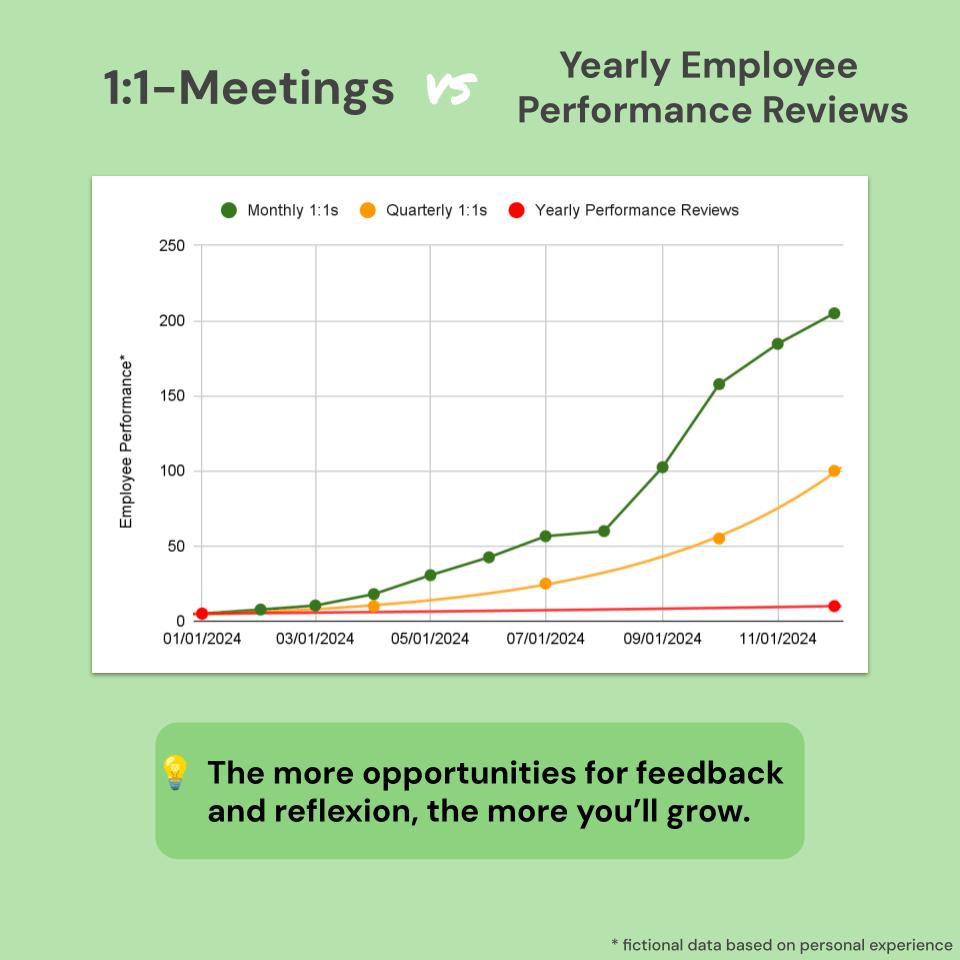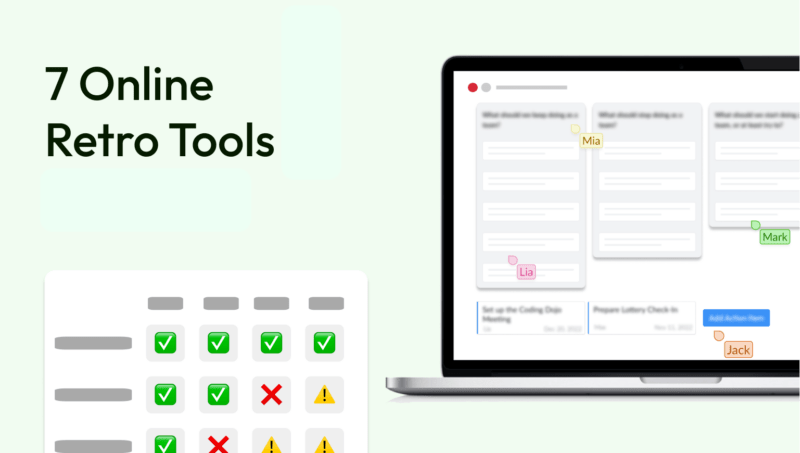Successful one-to-one meetings are an important tool for managers to build a strong relationship with their employees and to promote and develop your staff. In this article, you will receive a comprehensive guide that explains what 1-to-1 meetings are, what their purpose is, how to run them and what tips and guidelines you should keep in mind.
What is a one-on-one meeting with staff?
What is a one-to-one meeting with employees anyway? A 1-on-1 meeting is a regular, face-to-face meeting between a manager or team lead and an individual employee. These meetings provide a space in which concerns can be discussed, feedback exchanged and common goals defined.
The focus is on the individual development of the employee as well as on clarifying obstacles and setting priorities. Unlike general team meetings, (at least successful) one-on-one meetings or employee performance reviews are individual and tailored to the needs of the person in question.
Important: The one-to-one meeting is still a business meeting. Of course, it can sometimes be more informal, but it should be clear at all times what added value you are achieving with the one-to-one format.
Now you should be clear about what a one-to-one meeting is. Let's move on to the next step in our guide to successful 1-to-1s: the aim and purpose of one-to-one meetings.
Added value, goals and purpose of one-to-one meetings
Purpose of one-on-one meetings
The purpose of a successful one-on-one meeting is to create a private and trusting discussion format between the employee and the manager or team lead. When there is trust, your staff is much more likely to openly communicate their ideas and obstacles.
The regularity of the one-to-one meetings also significantly speeds up communication about current tasks in the team and any misdirected initiatives by your staff are recognized early on. Part of successful one-to-one meetings is therefore also a regular cadence – more on this below.
By the way, I have now also made a YouTube video in which I present the results of my little research: I asked 100 managers in qualitative interviews why they actually hold one-to-one meetings – feel free to take a look.
Aim of one-to-one conversations
In addition to the general purpose, the objective of a one-to-one meeting depends on the individual situation. Typical objectives of a successful one-to-one or regular performance review are
- Induction of a new employee
- Binding an employee to the company (or the team)
- Correcting performance problems (see "Performance Improvement Plan")
- Promoting the development of your staff within the company
- Feedback and general improvement of cooperation
Successful one-to-one meetings should address both the individual needs of the employee and contribute to the achievement of the company's goals if they are to follow all the rules of the art.
By the way: If you are a manager of software developers, the following article might be of interest to you: 6 Examples of feedback to software developers.
Added value of one-to-one conversations
Regardless of the specific goal for your one-on-one meetings or appraisal interviews, there are many added values that you can benefit from, at least if you follow the rules:
- Relationship building: A close connection between the manager or team lead and the employee creates trust and significantly improves communication.
- Increase motivation: Regular attention signals appreciation and strengthens commitment.
- Know satisfaction & intention to terminate: In times of a "war for talent", it is very valuable to know the satisfaction of your staff in order to be able to counteract any intentions of dismissal at an early stage.
- Opportunity for coaching: Managers and team leads can use appraisal interviews for coaching and give your staff impetus for their development.
All right, now comes the next step in our guide to 1-to-1s: how to run successful one-to-one conversations. Let's start with a simple question: What is actually a good one-to-one conversation cadence, how often should they take place?
Tip 1: Cadence of one-to-one meetings: How often should you have one-on-one meetings?
Let's start by answering the question of how to run one-on-one conversations by asking how often they should happen.
How often a regular performance review or one-on-one meeting should take place depends on various factors, such as the size of the team and the need for coordination in terms of content. There is no clear rule for this. Here is a typical recommendation for successful one-to-one meetings that also fulfill their purpose:
- Weekly: Ideal for fast-paced working environments or for new staff members.
- Bi-weekly: Often a balanced interval for most teams. Good starting point for one-to-one discussions.
- Monthly: For experienced employees with clear goals and stable performance.
Incidentally, a survey asked how often your staff would like to have 1-to-1 meetings with their managers. The answer is weekly! Source: Survey on 1:1 meeting frequency
So basically, the following tip is obvious: more frequent 1-to-1s meetings can have an exponentially positive effect on employee development, as this graphic shows:

Managers should define a fixed cadence for regular employee or one-to-one meetings at all times and then continuously adapt this cadence to the situation in dialog with the employee so that the purpose of one-to-one meetings can be optimally fulfilled.
As a manager, you now know how often 1-to-1 conversations should take place. The next step in our guide "How to run successful one-to-one meetings" is about the right duration of the meeting.
Tip 2: How long should a one-on-one meeting last?
Again, there is no clear rule for successful 1-1s. The typical duration of a successful one-to-one meeting is between 15 and 60 minutes:
- 15 minutes: Sufficient time for a regular check-in in a familiar format with a fixed agenda. If necessary, separate dates should be set for special topics outside the fixed agenda.
- 60 minutes: Leaves room for more in-depth discussions, such as development or career topics, in addition to the fixed agenda.
A clear agenda and efficient notes for preparation help to make the best use of time. Our tip is to schedule a little more time for the first regular appraisal interviews and then reduce the duration if necessary.
💡
According to a survey, the average duration of 1-to-1 meetings is 43 minutes – but we cannot judge whether they are successful on average.
Source: Report 1:1 meeting statistics
There is a great demand for one-to-one conversation templates. That's why, in the next step of our guide, I'll give you a short template so that the purpose of your one-to-one conversation can be optimally fulfilled. This also brings us closer to the core of the question of how to run successful one-to-one meetings.
"I like this employee, but he's underperforming. How can I address this in 1:1s?"
"I often don't know whether I was too hard – or too soft – in my 1:1s to make a positive impact."
"I can’t identify patterns or trends across my 1:1s. Everything feels isolated."
Tip 3: A simple starter template for one-on-one meeting agendas
You are basically flexible with the template, but there are a few rules for successful 1-1 meetings. To help you get started, here is a tried-and-tested template for successful one-on-one meetings and their agenda:
- Check-in: How are you? Informal exchange also on personal matters.
- Review: What have you been working on recently? What topics are you currently working on?
- Blockers & challenges: What blockers or challenges are you struggling with? How can I support you?
- Goals: What goals have you set yourself for the next week(s)?
- Further points of the employee or the Direct Report (e.g. feedback or ideas)
- Further points of the manager or the team lead (e.g. feedback or personal exchange on updates from the company)
- Opinion poll (optional): Regularly surveying the satisfaction of team members on various aspects (e.g. general satisfaction, feedback culture, leadership) in figures and making it measurable professionalizes your leadership.
The use of an agenda creates structure and provides security for both sides in the preparation of the one-to-one or employee meeting. This drastically increases the likelihood of a successful meeting that fulfills the actual purpose of the meeting.
By the way, there is a suitable article in our blog if you are interested in even more detailed templates: 15 proven 1-1 meeting templates to edit (free).
By the way, the 1-to-1 meeting tool Echometer offers various templates for your meeting routine. Here is just one example of many – - take a look at our tool:
👋 Welcome & Icebreaker
- How are you today, how has your week been so far?
📕 Topics Employee [name]
- ...
👈 Manager topics: Review
- What went well last week?
- What were the challenges?
👈 Manager topics: Priorities & Goals
- What are your main priorities for the coming week?
- Where do you need my support?
🤚 Conclusion
- Is there anything else you would like to discuss?
⁉️ Mood check (survey)
Two more specific tips or guidelines on the one-to-one agenda if you are considering adapting the one-to-one template:
- If you want to be successful, please don't skip the check-in during your one-to-one conversation. You have probably both just come from other appointments or contexts and need a few minutes to mentally adjust to the one-to-one meeting. The check-in is also a good opportunity to strengthen the relationship with the employee and convey mutual personal interest and appreciation.
- The agenda item "Other points from the employee" in the one-to-one meeting is intended as a collection point so that your employee can bring up any topics here that they are unsure about where to place. My tip is therefore not to remove it from the agenda and always ask proactively whether there are any topics in this regard. If not, you can always skip the point in the business meeting and at least this point won't stand in the way of the success of your 1-to-1 meeting.
A good guide also works with frameworks. That's why I don't want to deprive you of our short framework for one-to-one meetings. It will help you to optimally fulfill the purpose of your new meeting routine.
Tip 4: How to run development-oriented one-on-one meetings: A simple framework for one-on-ones
If your one-to-one meetings feel like a waste of time and are anything but successful, the following section is for you.
Many one-to-one or employee appraisals end in one-sided status updates from staff to their managers or team leads. Such one-to-one meetings with a reporting character often have little added value for the employee, they do not fulfill their purpose and above all mean additional work. In our view, these "status report 1-1 meetings" are therefore a waste of time and do not meet the requirements of a modern manager as a "servant leader".
See also: Servant leadership in an agile working context
We therefore strongly advocate that successful one-to-one meetings should always have a development-oriented focus in order to fully fulfill their purpose.
Development-oriented one-on-ones or employee appraisals follow a clear framework to maximize success:
- Continuous reflection: Reflecting together on past successes and challenges. Identify patterns together with your staff.
- Development goals: Developing appealing, individual development goals that match the employee's career goals increases employee loyalty and motivation.
- Development measures: Define and actively support concrete steps to develop the employee's skills so that they can achieve their goals.
Such a framework for successful one-to-one meetings provides orientation and promotes further development. The first step is to define a development goal – which is the next part of our one-to-one guide.
Tip 5: How to define and track goals for your staff in one-to-one meetings
Development goals can be another tool to give structure and direction to your one-to-one or performance reviews and thus maximize their success. Development goals should always fit the context in order to fulfill their purpose:
- To what extent does the employee's development goal match the goals of the team or the company? If this aspect of interlocking goals is relevant to you, I can recommend the framework of "Objectives and Key Results" as a tip.
- How does the development goal match the employee's personal interests and motivation?
Studies show that clear development goals – can increase employee performance by 12% to 15% without any financial compensation –. See: The influence of objectives on work performance.
The basis for successful one-to-one meetings: defining the development goal for your staff
Therefore, before defining development goals in your 1-1 meetings, you should also zoom out of everyday life to talk about the employee's long-term vision and the role in which the employee sees themselves in the medium or long term. Try to understand the employee's motivators well before you set about defining development goals together.
Our templates for check-ins can help you with this: 5 templates for regular employee check-ins.
Development goals should be clear, measurable and achievable in order to fulfill their purpose. You can use the SMART method to check the wording:
- Specific: Is the development goal clear and specific enough? If it seems too far in the future, could an earlier interim goal be defined?
- Measurable: There should be measurable indicators to evaluate progress. How will you integrate these measurements into your one-on-one meetings or regular employee appraisals?
- Attractive: The goal should be meaningful and motivating for the employee.
- Realistic: The development goal must be achievable for the employee. Is it realistic to achieve it with the workload, or would the areas of responsibility have to be changed?
- Terminated: There should be a clear time frame and, ideally, milestones so that progress can already be achieved in the upcoming one-to-one or employee meetings.
In theory, you can of course also use regular employee reports to check the status of targets. You can find out more about employee reports in this blog post with 5 templates.
Track development goals in one-to-one meetings
Keep the development goal as visible as possible in your One-On-One notes so that you are regularly reminded of it.
The development goal is regularly scrutinized in successful one-on-ones or employee appraisals and adjusted if necessary. In addition, measures that can be implemented as quickly as possible should be derived from the development goal so that progress can be continuously felt and the purpose of the one-to-one meetings can be fulfilled.
Ideally, you should always have one or two active measures for the development goal that you can discuss as part of your one-to-one or employee meetings.
Tip 6: One-to-one business meeting tools
Do you still feel insecure as a manager or team lead and don't really know how to run successful one-to-one conversations? I have already pointed out above that there is of course software for conducting one-to-one meetings. The beauty of 1-to-1 online tools is that they naturally take the basics of this guide into account.
If you are interested in existing tools in detail, I can recommend our article as an additional tip: The 3 best 1-to-1 meeting tools in comparison. If you want to try out what we think is the best tool for successful 1-to-1 meetings, you can get started right away using the following template. The tool can do much more than just record meeting notes – it has many templates, automations, suggested measures and helps you to have KPIs for employee development:
"I like this employee, but he's underperforming. How can I address this in 1:1s?"
"I often don't know whether I was too hard – or too soft – in my 1:1s to make a positive impact."
"I can’t identify patterns or trends across my 1:1s. Everything feels isolated."
The 5 most important tips for successful one-on-one meetings summarized
So, let's summarize again what you as a manager hopefully took away regarding successful one-to-one conversations and their purpose (apart from knowing what a 1-to-1 conversation actually is):
- Ensure regularity: A constant cadence, such as weekly or bi-weekly, is essential.
- Preparation & clean documentation: A clear agenda and structured notes make one-to-one meetings more efficient.
- Listening: Give the employee space to express his/her concerns.
- Promote development: Use one-on-ones and regular employee appraisals to define long-term development goals for your staff and actively support their achievement.
- Tracking: Record results and tasks in writing and create a joint commitment to implementing the follow-up.
With these tips and guidelines, your one-to-one meetings and regular employee appraisals will become a valuable tool for leadership and development.









